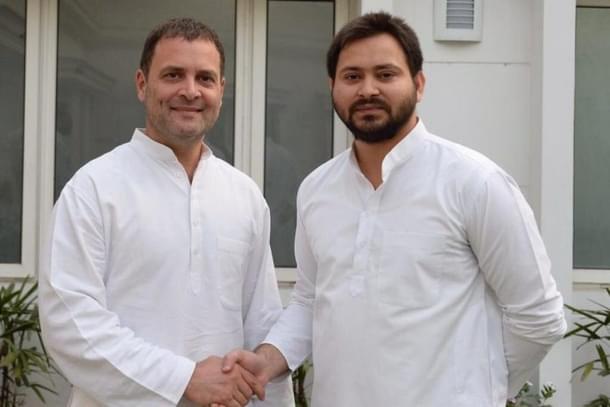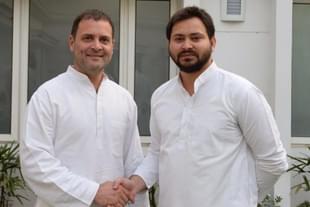Politics
Bihar Polls: Congress Tries Its Old Caste Arithmetic, But It May Be 30 Years Too Late
Jaideep Mazumdar
Oct 20, 2020, 10:39 AM | Updated 10:37 AM IST
Save & read from anywhere!
Bookmark stories for easy access on any device or the Swarajya app.


The Congress, which last held power in Bihar three decades ago, is desperate to regain a semblance of prominence in the state.
The party also wants to disprove the impression that it is overwhelmingly dependent on Lalu Prasad Yadav’s Rashtriya Janata Dal (RJD) for votes.
To achieve these twin objectives, the Congress has fallen back on a caste and community arithmetic that had kept it in power in Bihar for most of the 43 years until 1990. The party’s ‘winning combination’ was the votes of upper castes, Dalits and Muslims.
In a bid to revive this arithmetic, the Congress has distributed tickets to its once-traditional support groups. The party is contesting from 70 seats this time.
The upper castes have got the highest share of Congress tickets, followed by Dalits, Muslims and Other Backward Classes (OBCs). It has given 33 tickets to upper castes — 11 of them Bhumihars, nine Rajputs, nine Brahmins and four Kayasthas.
The upper castes, who form 15 per cent of Bihar’s electorate, had remained solidly behind the Congress until the Ram Mandir movement led them en masse to the saffron camp.
Dalits, who form 16 per cent of the state’s electorate, have been fielded by the Congress from 13 seats while Muslims, who form nearly 17 per cent of the state’s population, got 12 tickets.
The OBCs, even though they form 51 per cent of Bihar’s population, have been given 11 tickets by the Congress.
That’s because OBCs are firmly with the RJD, Janata Dal (United) or JD(U) and other smaller parties, and there is little chance of these sections voting for the Congress except in RJD strongholds where the RJD’s core Yadav votes will get transferred to the Congress.
And that’s only because the Congress is part of the RJD-led Grand Alliance (GA) or Mahagathbandhan. In 2010, when the Congress contested the assembly elections on its own, it bagged a pathetic four seats only.
But the Congress strategy seems unlikely to work. The upper castes are even firmly behind the Bharatiya Janata Party (BJP) now, thanks to the fructification of the ‘Ram Mandir’ dream and the grand ‘bhoomi pujan’ ceremony that Prime Minister Narendra Modi presided over at Ayodhya in August.
The BJP has, in its recent campaigns, highlighted the Congress support for restoring the pre-August 2019 status and the special privileges to the erstwhile state of Jammu and Kashmir and its ‘anti-Hindu stand’.
This has only helped upper caste support for the BJP to coalesce. The Congress’ aggressive espousal of ‘secularism’ and its perceived tilt towards Muslims has also served to alienate the upper castes.
As for Dalits, the Congress can really not expect their support. Thanks to Nitish Kumar’s social engineering success, all the backward castes have been brought under the ‘Mahadalit’ umbrella and have benefited from the JD(U)’s largesses showered on them these past 15 years.
And apart from the JD(U), the Dalit sub-groups also have their own parties like Jitan Ram Manjhi’s Hindustan Awam Morcha-Secular (HAM-S), Vikasheel Insaan Party (VIP) and Rashtriya Lok Samata Party (RLSP) to support.
The HAM-S and VIP are constituents of the National Democratic Alliance (NDA) while the RSLP broke away from the GA. The Dalit sub-groups whose allegiance they command will, thus, not vote for the Congress or the GA.
Ironically, the backward castes still look upon the Congress as a party of the privileged and upper castes. That impression got embedded in the minds of the backward castes in Bihar because all the Congress chief ministers belonged to the upper castes.
The Congress had failed to read the signs of and address backward caste aspirations that started surging since the late 1980s. Instead of accommodating the backward castes in the power structure, the Congress ignored them and continued to favour the upper castes.
The Muslims deserted the Congress after the 1989 Bhagalpur riots. It lost whatever little Muslim support it retained due to its ambiguous stand and actions during the ‘Ram Janmabhoomi’ movement and the demolition of the Babri Masjid in 1992.
Since then, the Muslims have supported the RJD and, of late, have also gravitated towards the JD(U). Nitish Kumar has succeeded in slowly but steadily weaning away Muslims from the RJD through his development agenda.
The Congress had also lost a lot of support in Bihar due to its imperial ‘high command’ culture with the state unit playing an abject minion to the Gandhi dynasty and its coterie.
This was infamously manifested in the party ‘high command’ changing six chief ministers in the 10 years between 1980 and 1990. The opposition merrily highlighted this as an insult to Bihari pride and reaped electoral dividends.
Unfortunately for the Congress, this culture still prevails. The high-handed removal of Ashok Choudhury as pradesh Congress chief in September 2017 over mere suspicion of ‘anti-party activities’ since he was not perceived to be subservient enough to Rahul Gandhi will cost the party dear.
Choudhury was one of the few mass leaders the Congress had in Bihar and after his removal, he joined the JD(U). He was rewarded with the education portfolio and is one of the most vocal campaigners against the Congress now.
The Congress has been on a steady decline since 1990, when it won 71 of the assembly’s 323 seats (Jharkhand was part of Bihar then). Its vote share in 1990, when it lost to the Janata Dal, was 24.78 per cent.
For the record, it had won 196 seats in 1985 and its vote share was 39.3 per cent. Ten years later, in 1995, its vote share declined to 16.3 per cent and it won 29 seats.
In the 2000 assembly polls, the Congress tally declined to 23 and its vote share fell to 11.1 per cent. The next elections in February 2005 saw the party losing more ground and bagging just 10 seats.
Elections were held again in October 2005 since the February polls had thrown up a hung assembly. The Congress bagged nine seats and its vote share fell to 6.09 per cent.
In the 2010 assembly elections that the Congress contested on its own, its tally fell to the lowest ever of just four, though its vote share increased marginally to 8.38 per cent.
The party improved its performance in the next elections in 2015 and bagged 27 seats, and a vote share of 6.7 per cent. But the improvement in its tally is attributed to its alliance with the RJD and the JD(U), which was part of the Mahagathbandhan that year.
The Congress bagged so many seats because the votes of RJD and JD(U) supporters got transferred to Congress candidates. Without that, there was no chance of the Congress winning in most of the seats.
This alliance is costing the Congress very dear in Bihar. It is seen as a party that has little existence and identity of its own except as an ally of the RJD.
Political analysts point out that on its own, the Congress will not win even the four seats it won 10 years ago. The only reason it wins seats in double digits is because of the transfer of RJD votes to the Congress.
The Congress is also battling the charge that though it had been in power for most of the 43 years between 1947 and 1990, Bihar declined on all indices and became a Bimaru state under it.
Congress strategists seem to have overlooked the fact that the party’s old winning caste arithmetic has become obsolete and caste equations and aspirations have changed decisively in Bihar.
Jaideep Mazumdar is an associate editor at Swarajya.





